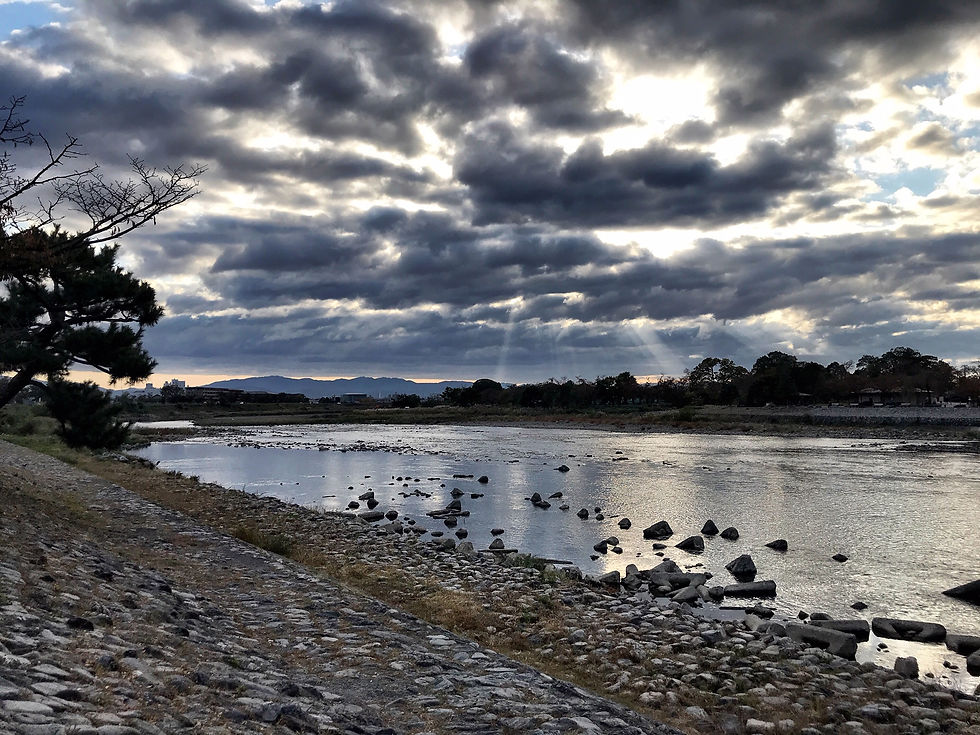Zazen at Tenryu-ji
- kirklmiler
- Nov 17, 2019
- 3 min read
This morning I woke before dawn to the cold, crisp air nipping at my ears in my tiny, Japanese house. I have now been in Kyoto going on five months and November is proving to be Japan’s most beautiful month. Temperatures now in the sixties, on one sunny day after another, then dropping into the forties and fifties when the sun sets around five in the evening.
As I have been endlessly inspired by the Japanese level of attention to every detail in their arts, their food, their everyday way of life, their attention to fashion and dress is no exception. Both Japanese women and men alike are impeccable dressers, setting a standard of excellence when they leave the house for the day each morning. I came to Japan to reinvent myself, thus my laid back, casual Austin manner has been consistently challenged daily.
So this morning I jumped from my warm bed into the cold, dark and made my way to my semi-outdoor shower. I quickly dressed and found myself running down the empty street to catch the 203 bus at 7am. Taking a bus across town to do zazen meditation requires you to really, really want to do it, especially in the cold. Some new Japanese friends had invited me to do morning meditation at their home temple in Arashiyama. Tenryu-ji is located in the center of the breathtaking Arashyima district, located just west of Kyoto. Arashyima, also known as “Storm Mountain” is famous for its bamboo groves, which are seen in awe-inspiring images all over the world. The grove runs along a scenic mountain across the Õi River. In November, the trees and foliage across the mountin are an artistic masterpiece. Tenryu-ji is the main temple of the Rinzai sect of Buddhism and also a World Heritage site.
I arrived as the sun was just coming up over the river and in a moment that resembled a dream, a flock of geese came toward me, along the water, seemingly in slow motion. I was tempted to quickly grab my camera, but was quietly inspired that some moments are just for me.

As with much of my experiences and life here in Japan, from calligraphy instruction to sumi e painting to tai chi, all of the instruction for zazen were explained at a rather rapid pace in Japanese. Since I have studied as a meditation teacher, I was clear enough to sit in lotus position, align my posture and attend to my breath. What is unique to Japanese Zen Meditation that was new to me was the monk’s use of what is referred to as an “encouragement stick.” During the silence of meditation, the monk literally walks around with a long wooden stick in the event anyone needs a gentle “posture reminder.” As I was doing my best to remain connected to my breath, I kept conjuring up images from the Al Capone scene with the baseball bat in the film "They Untouchables." The good news is that this is not a form of punishment and is only given upon request by crossing one’s arms shoulder to shoulder, then bowing. Fortunately, my training as a meditation teacher and tai chi training paid off, my posture remained strong, thus, no “encouragement” was needed.

After the hour of zazen, we then proceeded to tour the famous Sōgenchi Garden, a “special place of scenic beauty.” Interestingly, the first chief priest of Tenryu-ji was Musō Soseki, a Zen Buddhist Monk and teacher, calligraphist, poet and garden designer. He was the most famous monk of his time and I couldn’t help but notice our resemblance. He seemed to be a master in all of the aesthetics that drew me to to Japan.






___________________________
It would be merciful for people
not to come calling
and disturb the loneliness of the mountains
to which I have returned from the sorrows of the world.
-Musō Soseki



Comments